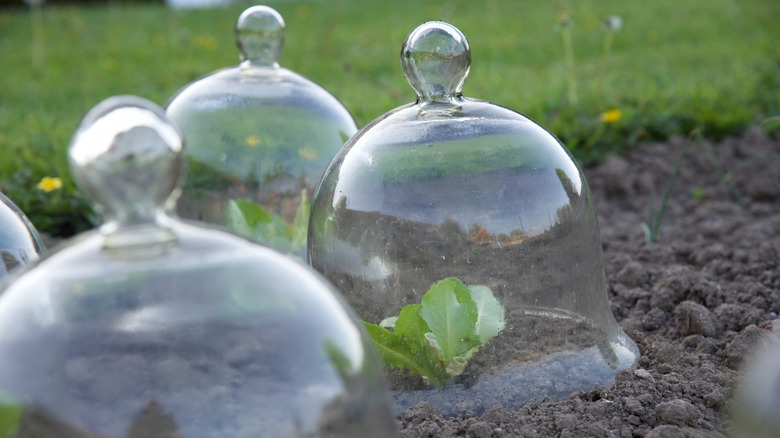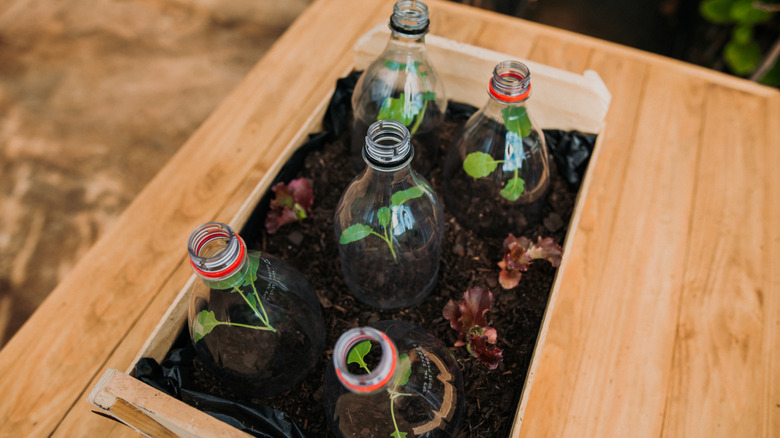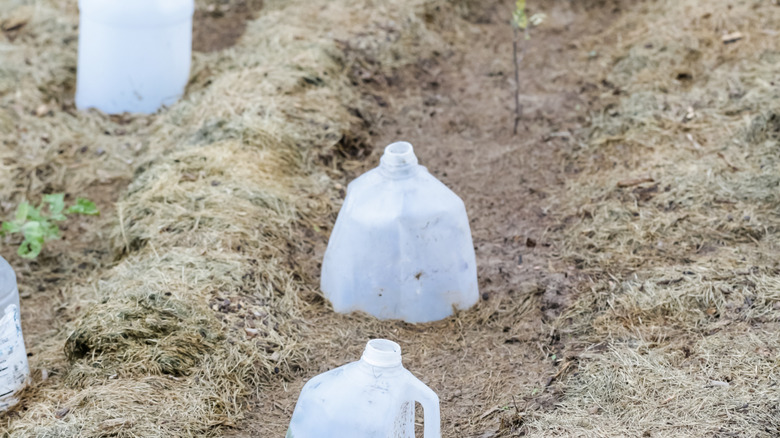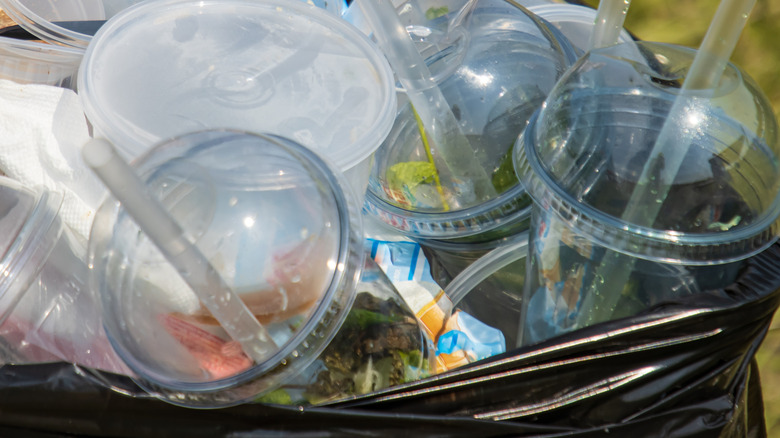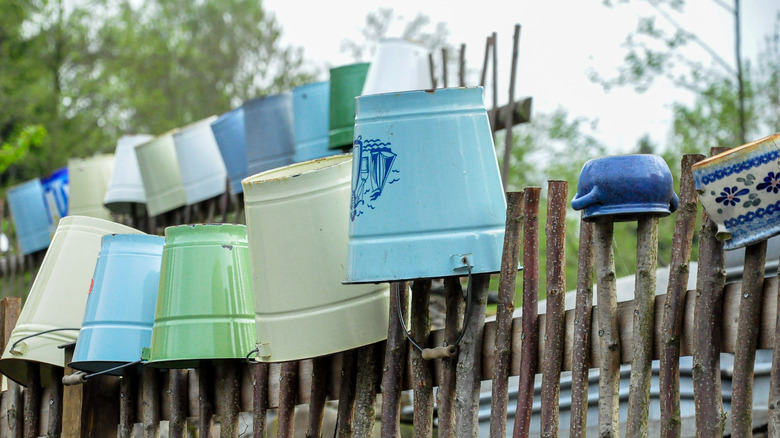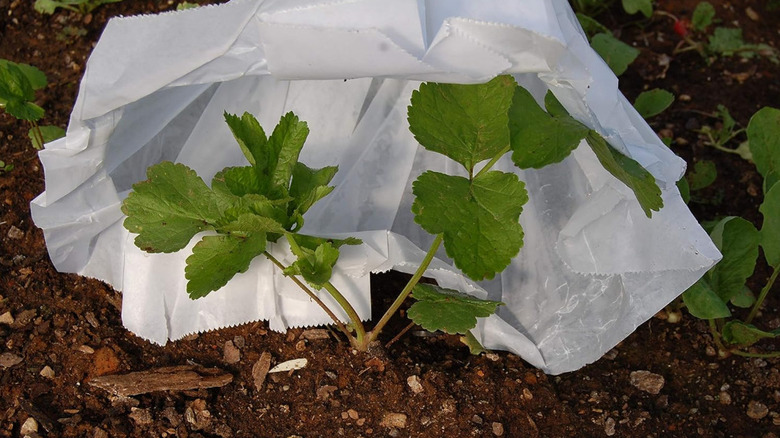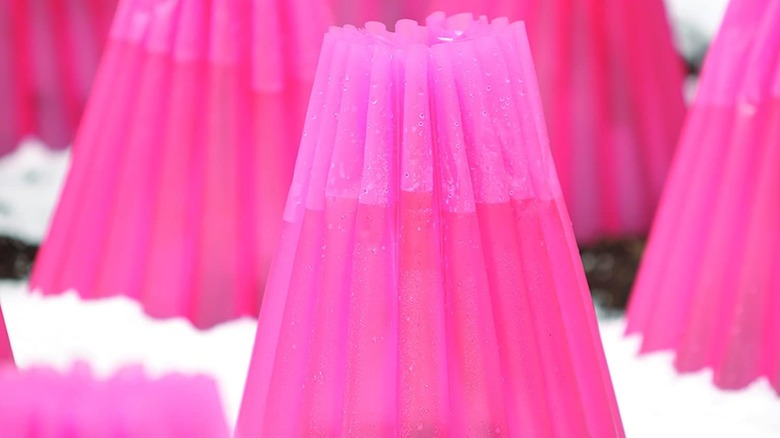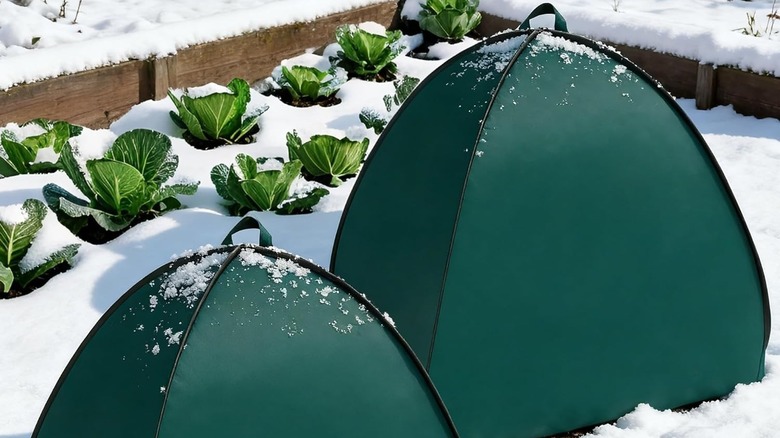12 Budget-Friendly Alternatives To Cloches That Will Protect Your Plants From Frost
We may receive a commission on purchases made from links.
The classic glass garden cloche has been both an ornamental and practical garden staple for centuries. These bell-shaped structures protect tender plants and seedlings from late fall and early spring frosts, potentially extending the season for weeks. It also helps to winterize perennials, so that you have decades of flowers, rather than ornamentals that succumb to early freezes. A cloche acts as a mini-greenhouse, raising daytime temperatures inside the dome during the day and retaining them at night. Alternatively, it can be removed during the day in milder weather. The only catch? Glass cloches can be expensive, especially if you have many plants to protect.
That's why practical gardeners turn to DIY and lower-cost alternatives to stretch their wallets. In many cases, homeowners also find a second life for household products that would otherwise be sent to the landfill. If you set your budget-friendly cloches over plants before sundown, the plants will radiate heat from the surrounding soil overnight, rather than allowing it to escape. Depending on the weather and what kind of cloche alternative you're using, you can either remove the cloche entirely the next morning or partially ventilate it for better air circulation and heat retention.
Plastic bottles find new life as plant protectors
With their ideal conical shapes, altered 2-liter soda bottles or family-sized juice containers genuinely look like old-fashioned garden cloches. More importantly, plastic bottle cloches are effective mini-greenhouses. Save the bottle caps for extra insulation at night. During the day, having the cap off allows for extra heat to get to the plant, which can then be trapped by screwing the cap on before sundown.
Plastic bottle cloches aren't difficult to make. After rinsing out the plastic bottle, scrub off the product labels and other stickers under running water. Removing these allows 360 degrees of sunlight to reach the plant inside. Next, carefully cut off the lower one-third or so of the bottle using scissors or a utility knife. Make the cut just before it starts to taper inward again, so that you achieve the classic bell shape. Once you've set the plastic bottle cloches over individual plants outside, monitor them carefully to see how they're adjusting. If there's too much humidity buildup during the day, consider removing the bottles altogether in milder weather. Replace the cloches at night, especially if there are frost advisories. Secure the bottles with a stick placed inside the bottle, or brace it on the outside with one or two garden stakes.
A milk (jug) does a garden good
Don't throw out old milk jugs, and reuse them in the garden as makeshift cloches. A gallon milk jug may be used as a cloche replacement, much as you would a plastic soda bottle. (Of course, other gallon-sized beverage jugs may also be used, whether they held chocolate milk, lemonade, or punch.) These jugs even offer a few additional features. First, they have handles, which makes removing and replacing them in the garden even easier. Secondly, after you cut away the jug's lower section, you can reserve that bottom for a seed-starting bed, which you cover at night with the top part of the jug.
As with soda bottles, start by cutting off the lower one-third or so of the jug with scissors or a utility knife. Thoroughly wash your DIY cloche, and remove any stickers or labels. If you wish to use the segmented jug as a seed-starting mini-greenhouse, wash out the bottom part as well. Poke holes in the bottom for drainage before adding potting soil and seeds. At night, set the cloche part of the jug over either this seed planter or over other plants in the garden. To keep the jugs secure, twist them securely into the soil, or cut a slit on one side of each jug so you can secure it with a garden stake.
Have a water cooler moment in your backyard
Used 5-gallon water cooler jugs make excellent DIY cloches for larger ornamental plants and vegetables. Source them through a local water cooler service or from friends who buy the jugs for home use. Much like soda bottles and milk jugs, repurposed empty 5-gallon water jugs only need their bottoms removed in order to work effectively in the garden. Unlike these smaller cloche alternatives, however, these can protect taller and wider plants from frost.
Remove the bottom section of the water cooler jug with a utility knife, and wash it out with soapy water. Fit the jug inside your tomato, eggplant, or pepper cage. Alternatively, set one altered jug over groups of seedlings or perennial flowers. Either remove the entire structure during the day during warmer weather, or jack the jug up with boards for air circulation. At night, consider plugging the mouth of the water cooler jug with its cap or some cloth for extra protection. As with other bottle and jug-type cloches, secure the sides with extra garden soil, or set stakes through the top or around the sides. This precaution keeps the wind from blowing the water cooler cloche off the plant.
Use budget-friendly Mason jars to store daytime heat
You probably already know some handy ways to use old Mason jars, but there always seem to be more tips for repurposing them! In fact, the humble jar has long been used by gardeners as a budget-friendly alternative to expensive cloches. As a bonus, you don't need to cut off any bottom sections in order to use them. Instead, just invert them over any plants needing frost protection. Whenever possible, use wide-mouth Mason jars in the garden. This type slides more easily over larger plants as you're setting them into place and is more stable at the base.
Simply place the glass jars upside-down over individual plants. If you own a good selection of various-sized Mason jars, pair the jar size with the plant size. Put smaller, quarter-pint or half-pint jars over seedlings, and larger, half-gallon jars over small ornamentals and young vegetables. During the day, remove the jars entirely, or prop them up with a board for air circulation. Don't have Mason or other canning jars? Other small glass vessels work in much the same way. Perhaps you have a chipped glass bowl you're willing to sacrifice to the cause of plant protection! Alternatively, reuse jars that once held food products, such as pasta or jam.
Tuck potted plants into budget-friendly bubble wrap
Rather than struggling to set an expensive cloche over a container plant, wrap the entire pot in bubble wrap. This is a simple and low-cost item that can protect your plants from cold weather. The most budget-friendly way to use bubble wrap, of course, is to save the packing material when you receive mail-order goods. But even when you have to purchase them new, bubble wrap sheets are kinder to your wallet than classic garden cloches. And, unlike glass cloches and many DIY alternatives, bubble wrap offers literal flexibility. The sheets can be fastened around an entire plant, including the container. This method also works for potted plants that you're storing in an unheated area for the winter, like a shed or a garage.
Start by creating a simple framework around the plant itself, so that the bubble wrap doesn't touch it. Literal sticks or garden stakes work handily for this makeshift cage. Place the sticks in the potting soil around the plant. Next, set the pot in the center of the bubble wrap, and pull it up and around the container and its new "cage." Then, secure the bubble wrap with clips or clothespins. During sunny days, unclip the wrap for ventilation, then secure it again before cold nights.
Get plastic cups out of the landfill and into the garden
It's amazing what a single pack of party-sized plastic cups can do in the garden! That's especially true when you have dozens of seedlings that need frost protection at night. In fact, the party size (usually around 16 ounces) makes the perfect mini-cloche to provide the space needed between plant and plastic surface. Choose the clear style to ensure that the tender seedlings get the most sunlight possible during the day. Even better, rinse out and save your fast-food beverage cups in anticipation of the frost season to reduce waste. However you come by the cups, their most obvious advantage comes from being free or low-cost, especially if you have many seedlings to protect.
Use one cup per seedling. Reserve these mini-cloches for young plants that are several inches shorter than the top of the cup, so that leaves don't come in contact with the plastic. It's that space between the plants and the cold air that provides protection. Twist the cups into the ground so that they're as firmly in place as possible. On windy nights, small rocks can help weigh down the cups. Because the cups are on the flimsy and small side, it's easier to just remove them in the morning, rather than prop them up. Then, replace them before the temperature plummets.
Give clear plastic food containers a second life
Chances are, you already rinse out and save food containers for a myriad of later uses. One clever way to repurpose empty ice cream containers and prepared food tubs is to turn them into budget-friendly cloches. For the most versatile garden cloches, choose containers that are clear or slightly opaque. These types allow plenty of sunlight to reach the plant during the day. The most likely candidates include ice cream buckets and larger deli containers. Smaller plants can be covered with plastic containers used to package berries or cherry tomatoes.
Place these containers upside down over plants, after poking holes in what will become the tops, for air circulation. (Produce packaging may already be perforated.) Pair the right-size container with the right-size plant. Ice cream buckets fit over young vegetables and some ornamentals, while deli containers and other packaging cover seedlings and other small plants. Use a rock or brick to weigh them down, and either prop them up or remove them during sunny days.
Line cheap waste baskets or tomato cages with clear plastic
An upside-down wire wastebasket acts as a frost cloche when it is lined with protective material like clear plastic food wrap or purchased frost cloth. Likewise, an inverted wire tomato cage paired with a frost-protecting material also becomes a low-cost cloche. As a bonus, either of these can also offer protection from foraging pests. For optimum sun exposure, choose types that have large holes for the sun to penetrate, rather than a tight-mesh type of wastebasket or cage.
Line the tomato cage or wastebasket with clear plastic food wrap. You can also use a commercial product such as frost cloth. Burlap or old cotton sheets will also provide frost protection, although you'll need to remove the makeshift cloche in the day so that the plants and surrounding soil benefit from the sun's rays. Invert the cage or wastebasket over the plant in order to create the dome effect. If needed, you can secure these with rocks on top of the domes or stakes set around them.
Boxes, buckets and planters can also make for emergency coverings
Household items like cardboard boxes, mop buckets, and plastic plant pots protect plants from frosty nights. Although few of these opaque containers let sunlight in during the day, they're still useful backups during surprise cold snaps. Place them over tender plants before sunset, and remove them in the morning. As long as the item has one open side to set over the plant, and is tall and wide enough to fit over the plant you want to protect, it can work as a temporary cloche.
Needless to say, your list of household items is endless when it comes to creating DIY cloches for temporary use. Potential materials include cardboard boxes, mop buckets, storage bins, plastic planters, unused ceramic plant containers, and similar items. Just make sure to brush away debris from old boxes or planters. As with other lightweight frost protection, it helps to weigh down the top of each makeshift cloche, or set stakes around it. Remove these household items during the day so that the soil can be warmed.
Cap off your frost protection project with hot caps
Hot caps operate almost exactly like the classic glass cloche, except that they are made out of inexpensive waxed paper. Because of the economical material, you can generally find them in multi-packs, such as Hot Kap's Regular Size Plant Covers. The individual cloches work out to less than one dollar per hot cap, depending on the size. Some may even be offered with soil "staples" to secure them into the ground. Look for types that have flaps which can be opened during the day and closed at night. Alternatively, the instructions will show you where to cut slits into the top.
Set these bell-shaped covers over plants, ensuring that the inner surface doesn't touch the leaves. To secure the lightweight structure, use soil staples or garden stakes. Alternatively, bury the edges in soil. For ornamentals, you may choose to remove the hot cap in the mornings to show the plants off. Seedlings and vegetables can remain covered because of the ventilated slots or flaps, but do check them periodically to ensure they're not being overheated or outgrowing the cap.
Water walls offer extra insulation at a low price point
Larger, heat-dependent plants such as tomatoes, eggplants, and peppers benefit from "water walls," such as Kozy Coats Insulating Plant Protector. These, and similar products, create a teepee-shaped structure that surrounds each plant. A typical water wall contains several attached tubes that, when filled, allow the cloche-like structure to stand on its own. The water heats up during the daytime and releases that heat to the interior plant during the cold nights.
Fill each hollow section of the structure, and set the water wall around the plants. The budget-friendly cloches work well in garden beds, inside plant cages, or within individual containers. Because they're heavy after filling, water walls are better suited for ornamental plants that show above the top or that you don't mind visually shielding. (These cloche alternatives are too unwieldy to remove and replace on a daily basis.) Once the water walls are no longer needed, remove them from the garden, drain them, and store them until they are next needed. This longevity makes the already inexpensive alternative even more of a bargain.
Keep plants cozy with budget-friendly jackets or tents
Protective "frost jackets" or "frost tents" offer reasonably low-cost alternatives to traditional cloches. These products keep plants shielded from damaging cold temperatures and winds. These covers, such as DECHOE's Pop Up Frost Protection Tent, come in various sizes. Another example, the Master Gardener's Frost Jacket, is designed to protect a plant that's 3 feet tall and wide. For bigger plants, options like REMIAWY's Shrub Jacket fit over larger shrubs and trees.
Pop-up frost tents are domed-shaped and made of lightweight but protective fabric. Like camping tents, many frost tent systems include stakes to secure the structure in place. Covers or jackets may be secured by a drawstring bottom. They're made from a material that's similar to frost cloth that lets in sunlight, but they're manufactured in such a way as to protect individual plants. Remove each one during the day so plants can get access to the sun and water. Frost tents and frost jackets are welcome innovations for gardeners who are watching their wallets, but still hate to wrestle with longer pieces of cloth in order to protect individual plants.
